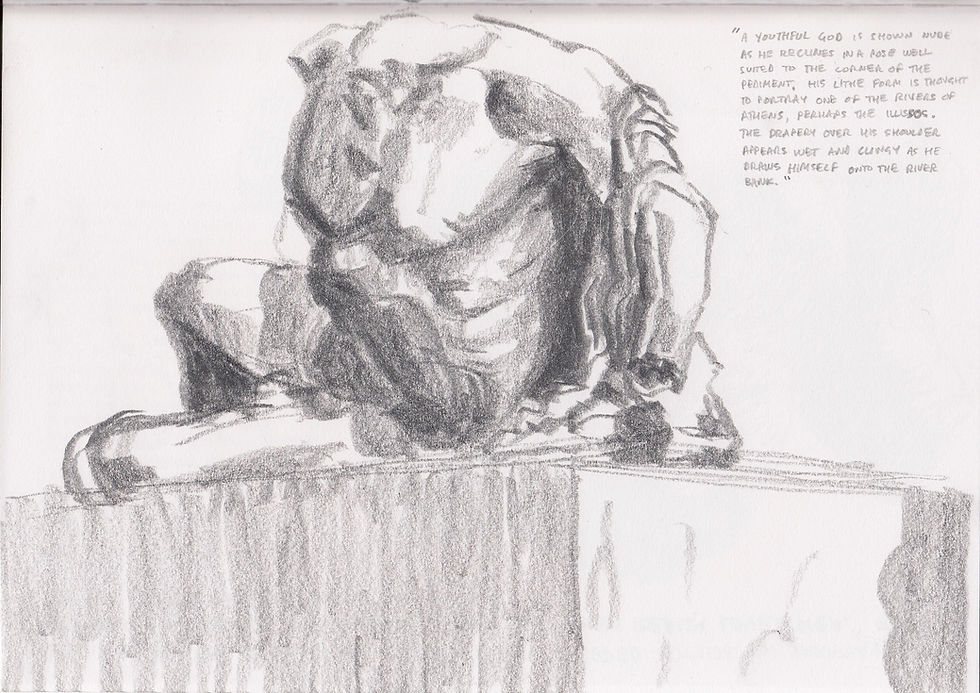FRINGE SEMIOTICS: on the origins of Hulk's haircut
- Ben

- Jun 16, 2022
- 3 min read
Updated: Nov 2
In the summer of 2020 I started revisiting Jack Kirby's artwork for Marvel Comics. In particular I was looking at his early drawings for his masterpiece of nuclear-gothic, the Incredible Hulk, first published in May 1962:


My first attempts to copy Kirby's drawing were not, in my opinion, excellent. This one just looks wrong:

This one's head is way too wide and squashed:

Still having trouble with the shape of the head here - having to add more hair to make it bigger, ending up with a big black bubble around the whole thing:

I eventually gave up on his head altogether and tried a hand instead (bottom. The top hand is after a drawing by my cousin Benji, which seemed somehow similar to me):

Things didn't improve much when I renewed my attempts this year:


Apart from anything else, I was still repeatedly failing to make his head tall enough. In ancient times I had studied the seminal text of American comic book art, How To Draw Comics The Marvel Way, by Stan Lee and John Buscema. Amid a torrent of sexist and otherwise-normative assertions, this terrible/wonderful book taught me that the human head is an oblong with the eyes resting half-way down (as in this page, on drawing the female face):

Looking at his Hulk drawings, I had the impression Kirby was roughly following the orthodoxy described in the book - with the exception, maybe, of making Hulk's head a little more square than usual. But my drawings, with their evasive hairlines, were saying otherwise. I resorted to tracing paper:


And then I did some measuring:

What I discovered was that, as drawn by Kirby, Hulk's head did not follow the Marvel rules. Although it looked square to me, it was in fact more wedge-shaped; about 1.3 times taller than it was wide and a good bit wider at the top than at the bottom. More like a bucket than a saucepan. Equally important, the eyes were a good bit below the half-way-down point on the face. Staring at these discoveries, and at my earlier drawings, I remembered an interview I had read with Stan Lee some years earlier in which he said the inspiration for the Hulk had come in part from Mary Shelly's Frankenstein; he wanted a character that was, in his words, 'a good monster'. He referred in particular to the films made in the 1930s, starring Boris Karloff. Thinking about this, an image of Karloff now rose in my mind and it was suddenly clear to me how Kirby had arrived at not just the shape of Hulk's head but also his hairline.


Born in 1917, Jack Kirby would have been 14 years old when the first of the Frankenstein movies came out. The films were hugely successful and the image of Karloff in makeup is still the first thing that comes up if you search for 'frankenstein' on the internet. It seems clear to me that, having discussed the inspiration for the Hulk with Stan Lee, Kirby went straight to the most obvious answer to the question of what the character should look like. Once you put the two hairlines next to one another, it becomes almost impossible to avoid the conclusion that the Hulk is not only a direct descendent of Karloff's monster, he also uses the same barber. According to the internet, it was a man called Jack P. Pierce who was responsible for the makeup effects in the Frankenstein films. Here he is, working on that iconic fringe:

I hope you'll agree that, since arriving at the above insights and relinquishing my desire to mimic Kirby's style, my drawings of the Hulk have improved dramatically:


I particularly like the eyebrows in the top left one here:

With these (below) I was thinking about the loose lines of illustrators who came up in the 1970s, like Quentin Blake, or Rius, whose Cuba For Beginners has been a great inspiration for me:

POST SCRIPT: It's interesting to note Boris Karloff's hairstyles in other films. I'm not sure which one this (below) comes from. I think it's either Sous Les Verrous - the French version of a Laurel and Hardy film called Pardon Us, released in 1931 (the same year as the first Frankenstein film), in which he played an intimidating prisoner - or from The Lost Patrol (1934). To me, his brushed-forward fringe here is not totally dissimilar to that worn in Frankenstein. There's also another image of him with what looks like a fake eye, surely from another film, in which he wears his hair the same way.

According to Wikipedia, Boris' real name was William Henry Pratt and he was born in Surrey, England. Here he is, in Frankenstein makeup, with a cup of tea.

Thanks for reading!
Oh, yes, and the Hulk is 100% copyright and trademark and fully owned by Marvel Studios.



Comments